The Cellini Salt Cellar (in Vienna called the Saliera, Italian for salt cellar) is a part-enamelled gold table sculpture by Benvenuto Cellini. It was completed in 1543 for Francis I of France, from models that had been prepared many years earlier for Cardinal Ippolito d'Este. The Cellini Salt Cellar depicts a male figure representing the sea and a female figure that represents the earth. A small vessel meant to hold salt is placed next to the male figure. A temple-shaped box for pepper is placed next to the female figure.
Home » Tutti i post

Benvenuto Cellini | Saliera or Salt Cellar, 1540-1543

Francesco Primaticcio | Ulysses and Penelope, 1563
Francesco Primaticcio, also called Bologna, Le Primatice, or Primadizzi (born April 30, 1504, Bologna, Emilia [Italy]-died 1570, Paris, France), Italian Mannerist painter, architect, sculptor and leader of the first school of Fontainebleau.
Primaticcio was first trained as an artist in Bologna, under Innocenzo da Imola and later Bagnacavallo.
He also studied with Giulio Romano and assisted him in his work on the decorations of the Palazzo del Te in Mantua.

Daniele da Volterra | Unfinished portrait of Michelangelo, 1544
Artist: Daniele da Volterra (Daniele Ricciarelli🎨) (Italian painter🎨, Volterra 1509–1566 Rome)
Date: probably ca. 1544
Medium: Oil on wood
Dimensions: 34 3/4 x 25 1/4 in. (88.3 x 64.1 cm)
Classification: Paintings
Credit Line: Gift of Clarence Dillon, 1977
Accession Number: 1977.384.1

Daniele da Volterra | Mannerist style painter / sculptor
Daniele da Volterra - Presentation of the Virgin
Daniele Ricciarelli da Volterra (1509-1566) was born in Volterra, a town in Tuscany, the painter and sculpture became known as Daniele da Volterra. He was a mannerist artist best remembered for his work in connection to Michelangelo (1475-1564).
Before befriending Michelangelo, Volterra studied in Siena with Giovanna Antonio Bazzi, called Il Sodoma (1477-1549) and Baldassare Peruzzi (1481-1537), and then with Piero Buonaccorsi, called Perin del Vaga (1501-1547). During this time he helped to complete works in the Palazzo Massimo alle Colonne in Rome, as well as in the Trinitá dei Monti and the San Marcello al Corso.
Volterra’s commission for the Orsini Chapel in the Trinitá dei Monti, were frescos he did based on drawings by Michelangelo.

Pierre-Gérard Langlois | Abstract painter
Born in 1940 and died young, at fifty four years, in 1994, Pierre-Gérard Langlois was an French painter and lithographer. He signed some of his work the pseudonym G. Duroc.
He graduated from the Modern Arts School of Paris, then he attended the Academy of Beaux-Arts at Rouen and followed courses at the Ecole du Louvre. He had his first personal exhibition in 1965, in Paris at the Champs Elysées Théatre.

Rembrandt | Musical Company, 1626
The subject of this painting is a mystery: is it an exhortation to praise God through singing and string music, or a scene of seduction with the old woman as a procuress?
In any case, in this early work Rembrandt used elements from his own surroundings: his mother modelled for the old woman, and Rembrandt’s own features can be recognized in the young man. | Rijksmuseum, Amsterdam
Rembrandt | Musical Company, 1626 | Rijksmuseum, Amsterdam
On the face of it, the theme of Music Allegory is straightforward enough: a music party in an interior, a common subject in Dutch art, though one to which Rembrandt himself would never return.
Three figures - a seated young woman singing, a man playing a bass gamba and a standing youth playing the harp - make music while an older woman listens on.

Rubens and Brueghel | The Five Senses Allegory | Art workshops
The "Five Senses" is a set of Allegorical paintings created at Antwerp in 1617-1618 by two Flemish masters Jan Brueghel the Elder (Dutch painter, 1568-1625) and Peter Paul Rubens (Dutch painter 1577-1640), with Brueghel being responsible for the settings and Rubens for the figures.
They are now in the Prado Museum in Madrid.
They are all painted in oils on wood panel, approximately 65 by 110 centimetres (2 ft 2 in × 3 ft 7 in) in dimensions.
Peter Paul Rubens and Jan Bruegel the Elder | Allegory of Sight, 1617 | Museo del Prado

Thomas Sully | Portrait painter
Thomas Sully (1783-1872) was born in 1783 in Horncastle, Lincolnshire, England, the youngest son of nine children born to the actors Matthew and Sarah Chester Sully. At the suggestion of his father's brother-in-law, a theater manager in Virginia and South Carolina, the Sullys emigrated to the United States in 1792. Sully attended school in New York until his mother's death in 1794, when he returned to live with his family in Richmond. From there they moved to Charleston, South Carolina, where the future artist performed on the stage with his parents and siblings.

Thomas Sully | Mother and Child, 1827
Thomas Sully (June 19, 1783 – November 5, 1872) was an American portrait painter, who was born in Britain but lived most of his life in Philadelphia.
For biographical notes and works by Sully see Thomas Sully | Portrait painter.

José Rivas | Abstract painter
Born of Spanish decendants and raised in the West Coast, Jose is a Vancouver-based graphic designer and a graduate from Capilano Univerisity’s IDEA - Illustration and Design - Program.
A lover not a fighter, Jose lives to work because it feels like play.
A socialite by nature, he loves talking about food or films directed by Wes Anderson and Stanley Kubrick.
Among other things, He’s a sucker for color schemes and beautiful sunsets.

Cornelis de Vos | Mother and child, 1624
Cornelis de Vos (1584-1651) was born into a Catholic family in Hulst, near the border between Holland and Flanders. This area was hotly disputed during the Eighty Years War (1568–1648) and in 1596 the De Vos family moved to Antwerp, confirming their Flemish rather than Dutch heritage. Soon after, Cornelis became an assistant in the workshop of the Antwerp artist David Remeeus, securing the young man’s place in the Flemish artistic tradition.

Follower of Jan van Scorel | A Man with a Pansy and a Skull, 1535

Maarten van Heemskerck | Wonders of the World, 1572
Maarten van Heemskerck (1498-1574) produced designs for a set of engravings, showing eight, rather than the usual seven wonders of the ancient world.
His addition to the conventional list was the Colosseum in Rome, which, unlike the others, he showed in ruins, as it was in his own time, with the speculative addition of a giant statue of Jupiter in the centre.
They were engraved by Philip Galle and published in 1572.

Maarten van Heemskerck | Mannerist painter
Maarten van Heemskerck Self-portrait in Rome, 1553
Maarten van Heemskerck (born 1498, Heemskerck, Holland-died 1574, Haarlem), one of the leading Mannerist painters in 16th-century Holland working in the Italianate manner.
He spent a period (c. 1528) in the Haarlem studio of Jan van Scorel, then lately returned from Italy. Van Heemskerck’s earliest works—“Ecce Homo” (Musée des Beaux-Arts, Ghent) and “St. Luke Painting the Portrait of the Virgin” (Frans Halsmuseum, Haarlem), both dated 1532—while adhering closely to the Romanist style of Scorel, seek to outdo it by dramatic lighting and illusionistic effects of plasticity.

Maarten van Heemskerck | Portrait of Machtelt Suijs, c.1540-1545
Dutch Mannerist painter Maarten van Heemskerck (1498-1574) lived in Rome for four years (1532-36) and was deeply affected by the city's art and antiquities.
Here, the half-length, seated figure, the tense yet elegant hands, and even the grotesque classical mask reflect the impact of that experience, while the love of meticulously represented textures is traditionally associated with northern European art.

Agnolo Bronzino | Descent of Christ into Limbo, 1552
Mixing styles of the late High Renaissance into the early Baroque period, Mannerists often depicted their subjects in unnatural forms.
Bronzino’s works have been described as “icy” portraits that put an abyss between the subject and the viewer.

Salvator Rosa | Allegory of Fortune, 1659
Salvator Rosa (1615-1673) was one of the least conventional artists of 17th-century Italy, and was adopted as a hero by painters of the Romantic movement in the later 18th and early 19th centuries. He was mainly a painter of landscapes, but the range of his subject matter was unusually wide and included portraits and allegories...
For biographical notes and works by Rosa, see Salvator Rosa | Baroque Era style.

Salvator Rosa | Baroque painter
Salvator Rosa (1615 - March 15, 1673) was an Italian Baroque painter, poet and printmaker, who was active in Naples, Rome and Florence.
As a painter, he is best known as "unorthodox and extravagant" as well as being a "perpetual rebel" and a proto-Romantic.
He was born in Arenella, at that time in the outskirts of Naples, on either June 20 or July 21, 1615.
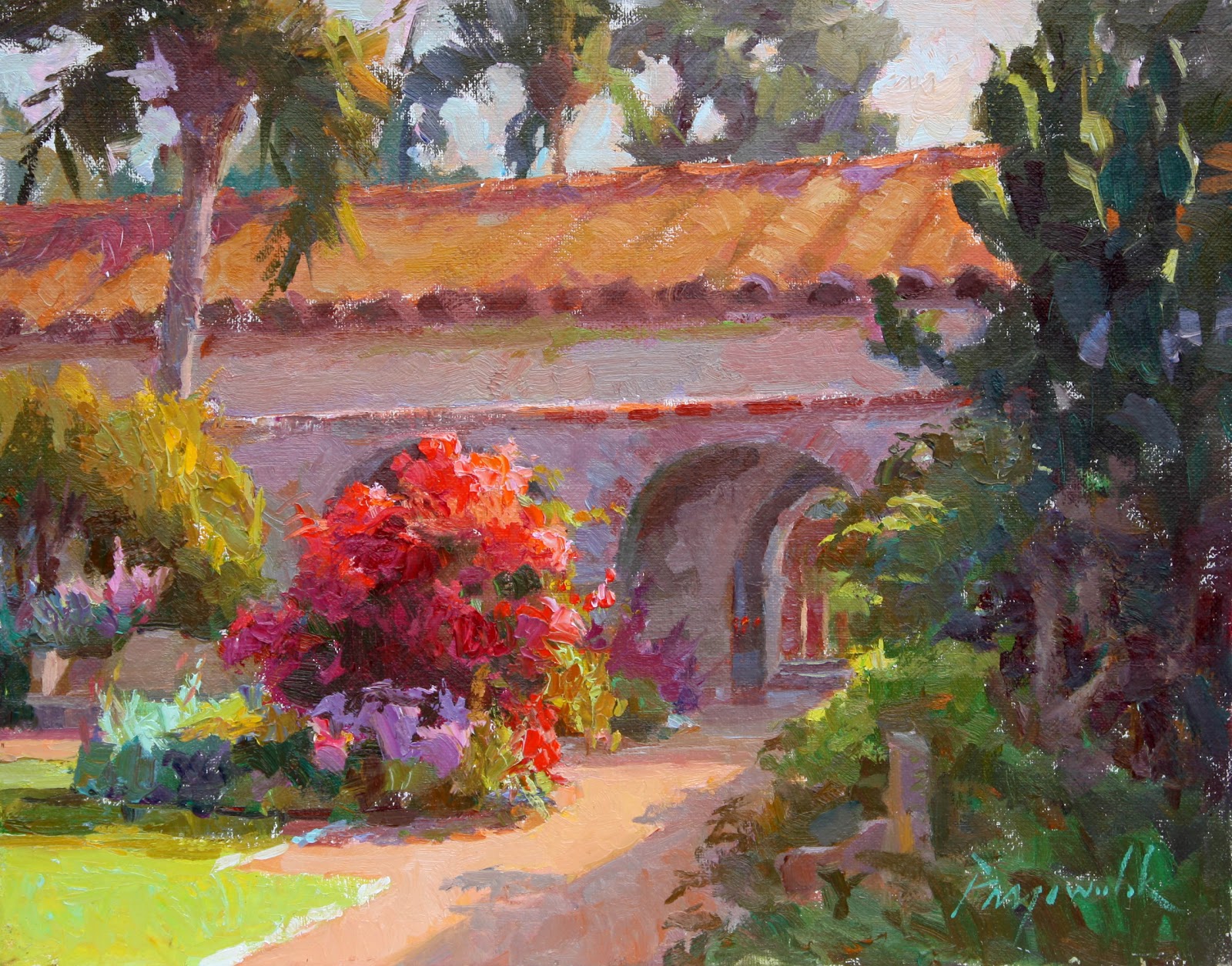
Camille Przewodek | Plein Air / Colorist painter
Camille Przewodek was born in Detroit, Michigan. She grew up inspired by her artistically-talented brother to pursue a career in art. After graduating with a degree in painting from Wayne State University, she migrated to the West Coast.
A perennial student, she saw fit to expand her “left brain” education with several semesters of political science at City College of San Francisco.
Later on she decided she’d like to train as a commercial artist so she enrolled at the Academy of Art College, earning a BFA in Illustration. At this point she met her future husband, Dale Axelrod, who introduced her to master painter, teacher and colorist, Henry Hensche.

Laugé Achille | Neo-impressionist painter
French painter Achille Laugé (1861-1944) was an Neo-Impressionist painter born in Arzens.
In 1882, he began his studies at the École Nationale Supérieure des Beaux-Arts under the direction of French artists Alexandre Cabanel (1823-1889) and Jean-Paul Laurens (1838-1921).
In Paris, he met artist Aristide Maillol (French painter, 1861-1944), with whom he shared a studio and maintained a life-long exchange and friendship.

Daniele da Volterra | Descent from the Cross, 1545
Daniele Ricciarelli (c. 1509 - 4 April 1566), better known as Daniele da Volterra, was an Italian painter, Mannerist and sculptor.
Daniele's best-known painting is the Descent from the Cross in the Trinità dei Monti (circa 1545), after drawings by Michelangelo; by an excess of praise this work was at one time grouped with Raphael's Transfiguration and the Last Communion of St. Jerome by Domenichino as the most famous pictures in Rome.

Renato Natali | Post-Macchiaioli painter
Benato Natali (1883-1979) was born in Livorno-Italy, from a modest family, where perhaps the father, hatter by profession, led him to enroll at the School of Arts and Crafts. Not too temperamentally suited to the school system began to devote himself to drawing a self-taught, and even when one of his companions urged him to attend the study of Guglielmo Micheli little and did so against his will.

Beppe Ciardi | Drawing
Giuseppe (known as Beppe) Ciardi (1875-1932) was an Italian painter.
Born in Venice, he was the son of the painter Guglielmo and the brother of Emma, who also became a notable artist.
Beppe Ciardi studied under his father at the Venice Academy of Fine Arts from 1896.
He graduated in 1899 and his participation in the Venice Biennale began the same year with the Esposizione Internazionale d’Arte di Venezia, where his work continued to be exhibited in later years and was featured in a solo show in 1912.

Giuseppe Arcimboldo | Allegories of the Elements, 1576
Arcimboldo - The four Elements - Air
As he did in "The four seasons", in the series of "The four elements" Arcimboldo assigned to any element a face formed by the most characteristic of any of them. Nevertheless, the series possesses some elements that make it quite different, and even more interesting, than the previous one.
First, and contrary to the previous series, every face is formed by only one kind of element. The face of "The Earth" is formed exclusively by land animals, "The Air" is made of birds, and "The Water" by fish and marine animals.

Giuseppe Arcimboldo | Allegories of the Seasons, 1573
Arcimboldo Giuseppe Spring, 1573
Giuseppe Arcimboldo painted numerous series about "The four seasons" (one in a private collection in Bergamo, painted around 1572; another one, painted in 1573, in the Louvre Museum) being each of them a copy without many variations of the previous one, reflecting the success of the series. The painter represented the hypothetical faces of every season with the most typical element of any of them. Thus the face of the spring is made of flowers, the summer has a face of fruits and a body of wheat, while the autumn is a curious summary of fallen leaves, fruits and mushrooms.

Giuseppe Arcimboldo | Drawing
Giuseppe Arcimboldo, also spelled Arcimboldi (1527-1593) was an Italian painter best known for working in the Mannerism style and for creating imaginative portrait heads made entirely of such objects as fruits, vegetables, flowers, fish, and books - that is, he painted representations of these objects on the canvas arranged in such a way that the whole collection of objects formed a recognisable likeness of the portrait subject.
For biographical notes and painting works by Arcimboldi see Part 1 - Painting.

Jimmy Lawlor, 1967 | Surrealist painter
Jimmy Lawlor was born in Wexford. He now lives in Westport, in the magnificent West of Ireland. Lawlor has been exhibiting for over 20 years.
His work is based not only on the Irish sense of humour, but on the vivid realisation that the old way of life will have vanished by our next generation.
His work takes elements from his surroundings and mixes them with the people of the place, in their environment and doing what they love best. In their own way, they have helped create the atmosphere around them, whether they be farmers, business people, students or otherwise.

Thomas Cole | The Voyage of Life, 1842
The Voyage of Life - Childhood (National Gallery of Art)
Thomas Cole's renowned four-part series traces the journey of an archetypal hero along the "River of Life. Confidently assuming control of his destiny and oblivious to the dangers that await him, the voyager boldly strives to reach an aerial castle, emblematic of the daydreams of "Youth and its aspirations for glory and fame. As the traveler approaches his goal, the ever-more-turbulent stream deviates from its course and relentlessly carries him toward the next picture in the series, where nature's fury, evil demons, and self-doubt will threaten his very existence. Only prayer, Cole suggests, can save the voyager from a dark and tragic fate.

Louis Rémy Mignot | Hudson River School
Louis Rémy Mignot (1831-1870) was among the Hudson River School style of painters and did numerous tropical landscapes of Panama and Ecuador as well as scenes of upper New York state and some of the Southern states. Louis Rémy Mignot was short lived, dying at age 39.
Louis Remy Mignot was born in 1831 in Charleston, South Carolina. His father Remy Mignot was a French Catholic immigrant who owned a confectionary shop in Charleston. His boyhood, during which he demonstrated a precocious artistic talent, seems to have been spent in his grandfather's home, near Charleston.

Frederic Edwin Church | Hudson River School
Frederic Edwin Church (1826-1900) was perhaps the best-known representative of the Hudson River School of landscape painting as well as one its most traveled. Born in Hartford in 1826, he was the privileged son of Joseph Church, a jeweler and banker of that city, who interceded with Connecticut scion and collector Daniel Wadsworth to persuade the landscape painter Thomas Cole to accept his son as a pupil.
From 1844-1846, Church studied with Cole in his Catskill, New York, studio and accompanied him on sketching sojourns in the Catskill Mountains and the Berkshires of Massachusetts. At one point, the master characterized the student as having "the finest eye for drawing in the world".

Eddy Roos, 1949 | Figurative sculptor
Eddy Roos (Amsterdam, 1949) is a Dutch artist and sculptor. He also choreographed 42 dance films and designs sculpture gardens.
A danced arabesque captured in bronze
The carefully reconstructed old- Dutch Renaissance-garden around the Groningen Verhildersum Manor at Leens forms in its idyllic setting of green lawns and delicately coloured flowerbeds the realization of a dream: from 1977 sculptor Eddy Roos is working on the realization of his own sculpture garden.
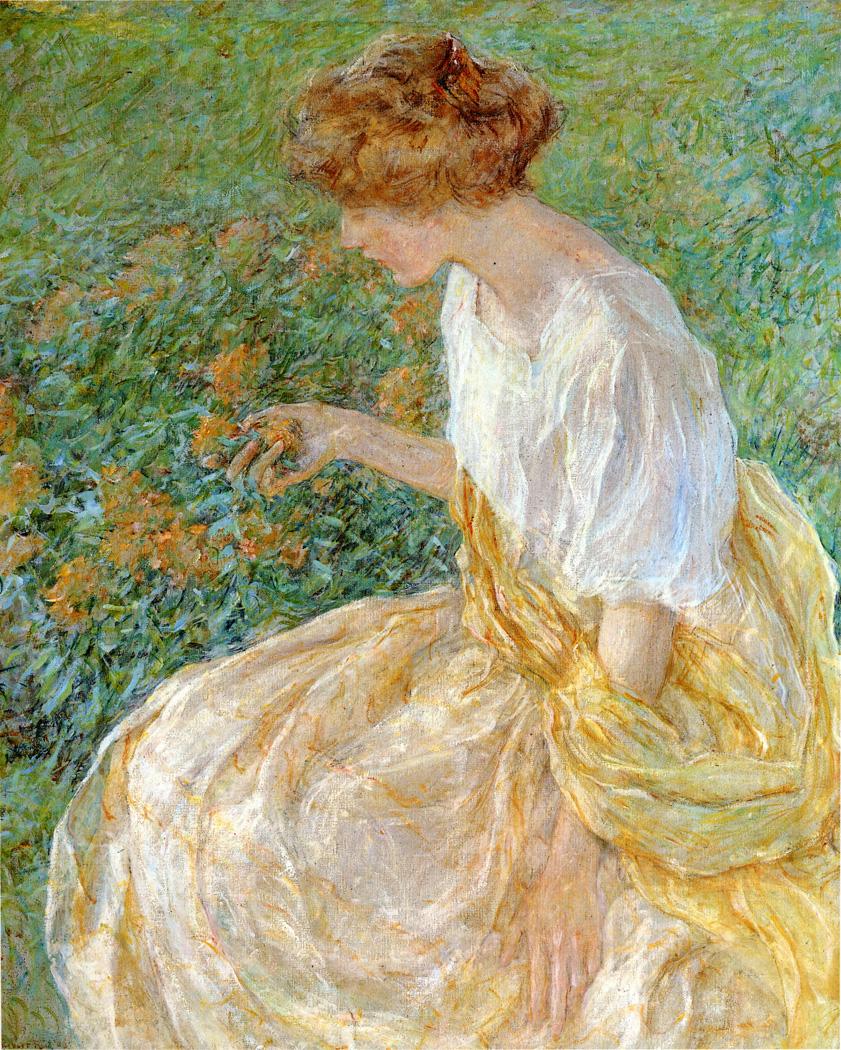
Robert Lewis Reid | Impressionist painter
Robert Lewis Reid (July 29, 1862 - December 2, 1929) was an American Impressionist🎨 painter and muralist.
Robert Reid was born in Stockbridge, Massachusetts and attended the School of the Museum of Fine Arts, Boston under Otto Grundmann, where he was also later an instructor. In 1884 he moved to New York City, studying at the Art Students League, and in 1885 he went to Paris to study at the Académie Julian under Gustave Boulanger and Jules Joseph Lefebvre🎨. His early pictures were figures of French peasants, painted at Étaples.
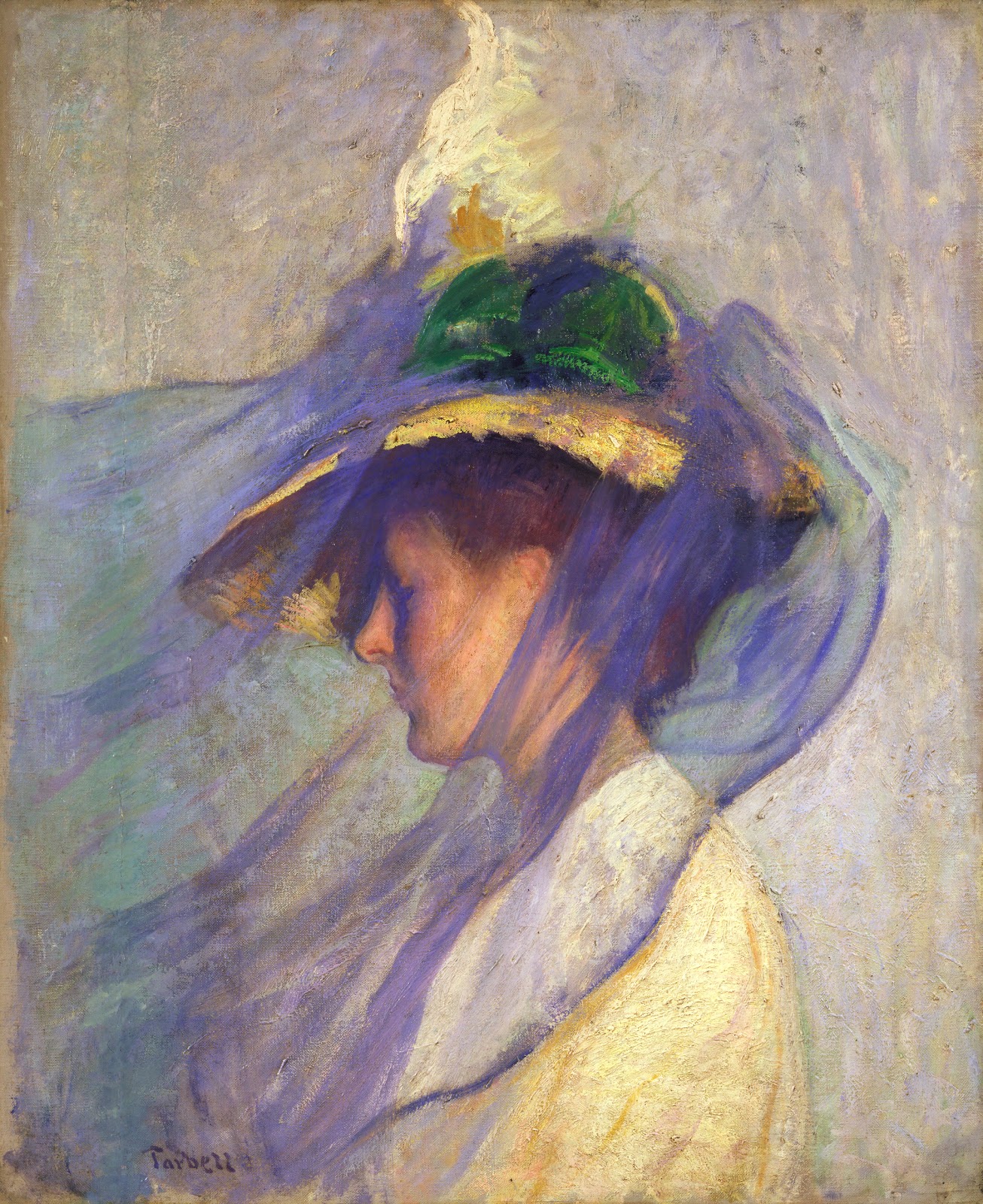
Edmund C. Tarbell | Impressionist painter
Edmund Charles Tarbell's (1862-1938) remarkable New Hampshire summer home is emblematic of the painter and his art.
Just as the artist's paintings draw upon traditional styles and motifs to construct an image of genteel New England, Tarbell's house blended the old and the new to create a rarefied atmosphere of history and domesticity.
On canvas, Tarbell repeatedly depicted modern life in terms of the past, arranging his female subjects in quiet interiors surrounded by icons of New England's glorious past, such as gate-leg tables, Chippendale chairs, and incense jars.
Tarbell's sitters read, knit, and drink tea as if in a historical vacuum.

August Gillé | Symbolist painter
August Gillé was a Belgian artist born in Mechelen in 1892 and died in Bonheiden in 1989. He was a painter and sculptor. Got his training in furniture manufacturing at the Academy in Mechelen (1910-1913).
Debuted as a furniture maker and sculptor. After the First World War, he started to focus on his great passion, painting. Then he took classes at the Academy in Mechelen (1919-1920) and Brussels (1922-1925).
As a painter, he evolved from expressionist figuration to spontaneous lyrical abstraction.
Realized approx. 10,000 works: oil paintings on canvas, drawings on paper, studies and sculptures.

Leonardo da Vinci | Della differenza ed ancora similitudine che ha la pittura con la poesia
Trattato della Pittura- Parte prima /19
La pittura ti rappresenta in un subito la sua essenza nella virtú visiva, e per il proprio mezzo, d'onde la impressiva riceve gli obietti naturali, ed ancora nel medesimo tempo, nel quale si compone l'armonica proporzionalità delle parti che compongono il tutto, che contenta il senso; e la poesia riferisce il medesimo, ma con mezzo meno degno dell'occhio, il quale porta nella impressiva piú confusamente e con piú tardità le figurazioni delle cose nominate che non fa l'occhio, vero mezzo infra l'obietto e l'impressiva, il quale immediate conferisce con somma verità le vere superficie e figure di quel che dinanzi se gli appresenta, dalle quali ne nasce la proporzionalità detta armonia, che con dolce concento contenta il senso, non altrimenti che si facciano le proporzionalità di diverse voci al senso dell'udito; il quale ancora è men degno che quello dell'occhio, perché tanto quanto ne nasce, tanto ne muore; ed è sí veloce nel morire come nel nascere.
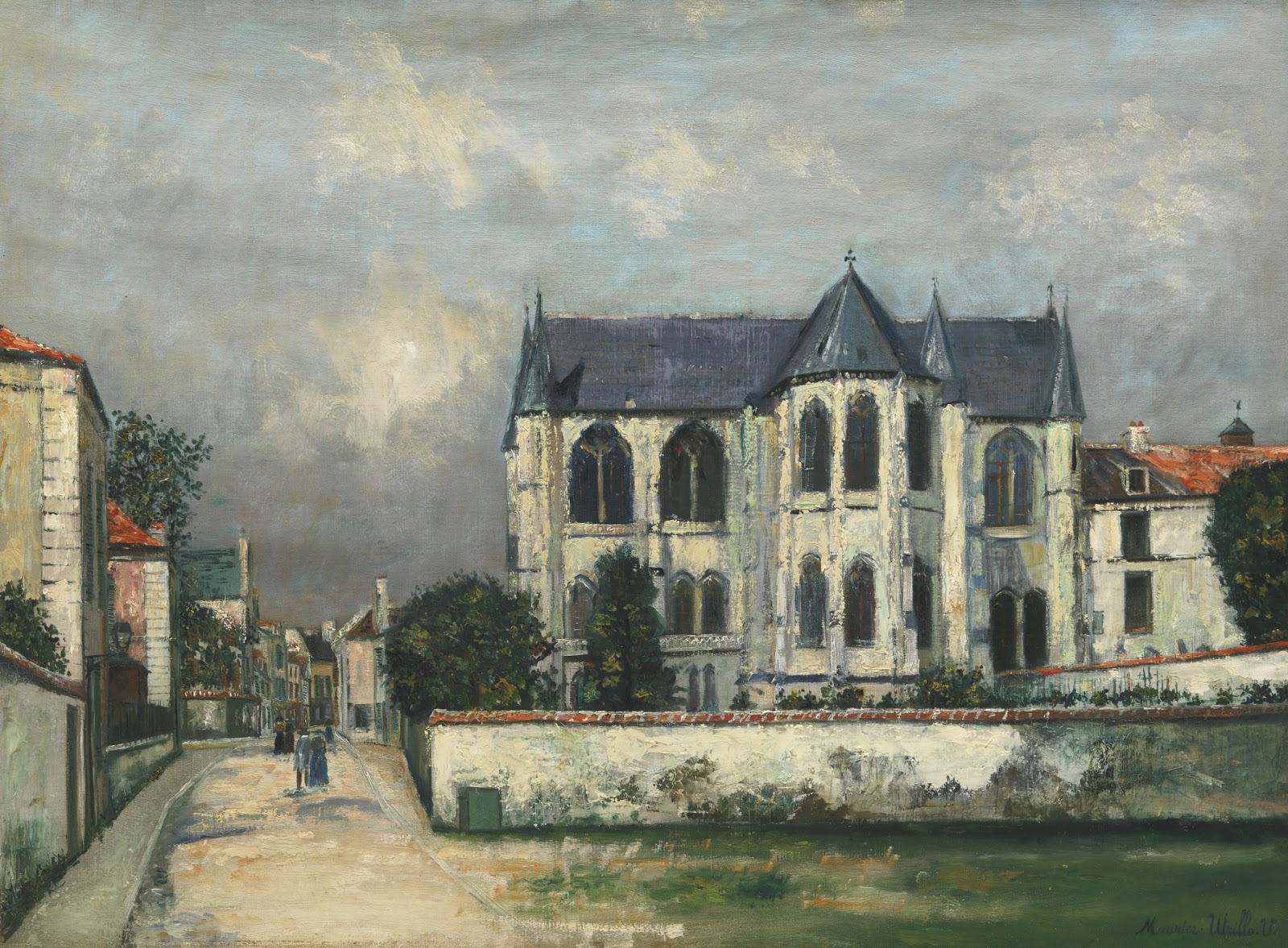
Maurice Utrillo | Post-Impressionist painter
Maurice Utrillo, (1883-1955), French painter who was noted for his depictions of the houses and streets of the Montmartre district of Paris.
Born out of wedlock, Utrillo was the son of the model and artist Suzanne Valadon.
His father was not known, and he was given his name by a Spanish art critic, Miguel Utrillo. He had no instruction as an artist apart from that given by his mother, who herself was untutored.

Manuel Gil Perez (Spanish, 1925-1957)
Manuel Gil i Pérez was a painter.
He studied at the School of Fine Arts of Sant Carles in Valencia.
In 1951 he received a Count of Cartagena Scholarship with which he made brief stays in France and Italy.
After residing in the United Kingdom for a year, he took charge of the murals at the Ateneu Mercantil in Valencia.
In 1955 he participated in the first Autumn Salon.
In 1957 he founded the Parpalló Group together with Eusebi Sempere, Andreu Alfaro, Salvador SoriaAnd others
His painting can be framed within expressionism, abstraction and neofigurativism.
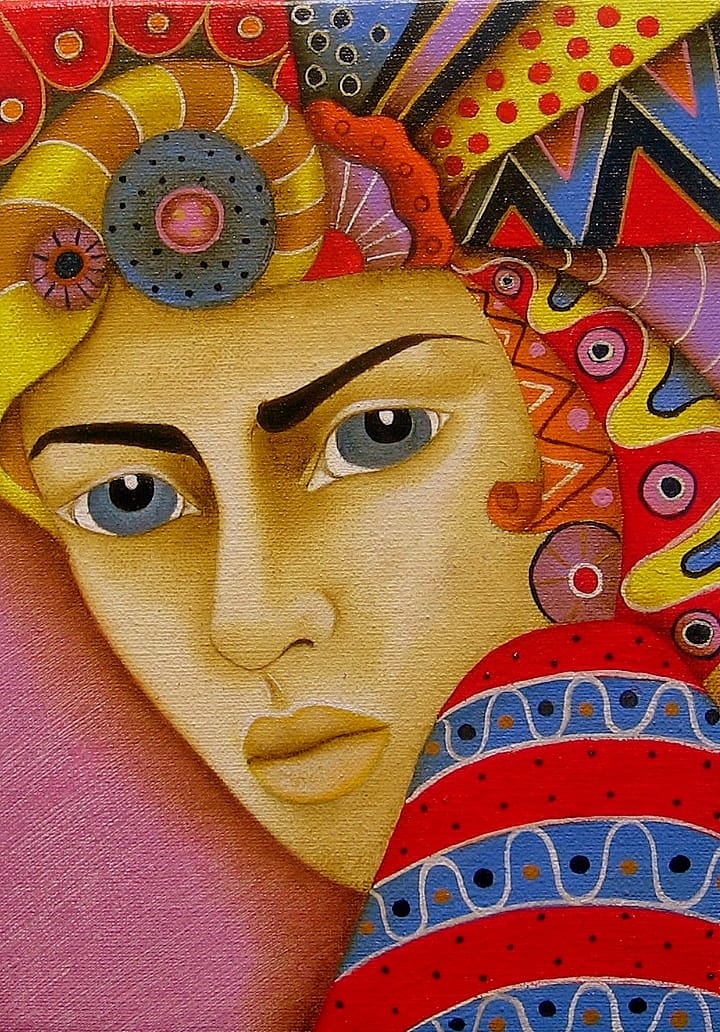
Jorge Rosensvaig, 1951
Jorge Luis Rosensvaig was born in Barranquilla, Colombia.
He studied architecture at the Universidad Piloto de Colombia in Bogotá (1972-1974) and later Fine Arts at the Universidad Nacional de Buenos Aires (Argentina, 1975-1979).
He completes his education between 1976 and 1983 with the workshops "Drawing and color" - Workshop David Mansur, Drawing with David Loockharta in Barranquilla and Color with Arturo Ludueña in Buenos Aires.

David Shterenberg | Avant-Garde painter
David Petrovich Shterenberg / Давид Петрович Штеренберг (1881-1948) was a Ukrainian-born Russian painter and graphic artist.
He was born to a Jewish family in Zhitomir, Ukraine.
After studying art in Odessa, in 1906 he moved to Paris where he studied in the Académie Vitti in Montparnasse where he was taught, among others, by the painter Kees van Dongen.
He lived in “La Ruche” where, at one time or other, there also lived Modigliani, Chagall and other artists.

Leonardo da Vinci | Qual è di maggior danno alla specie umana, o perder l'occhio o l'orecchio..
Trattato della Pittura- Parte prima /12
Maggior danno ricevono gli animali per la perdita del vedere che dell'udire, per piú cagioni; e prima, che mediante il vedere il cibo è ritrovato, donde si deve nutrire, il quale è necessario a tutti gli animali.
Il secondo, che per il vedere si comprende il bello delle cose create, massime delle cose che inducono all'amore, nel quale il cieco nato non può pigliare per l'udito, perché mai non ebbe notizia che cosa fosse bellezza di alcuna cosa.
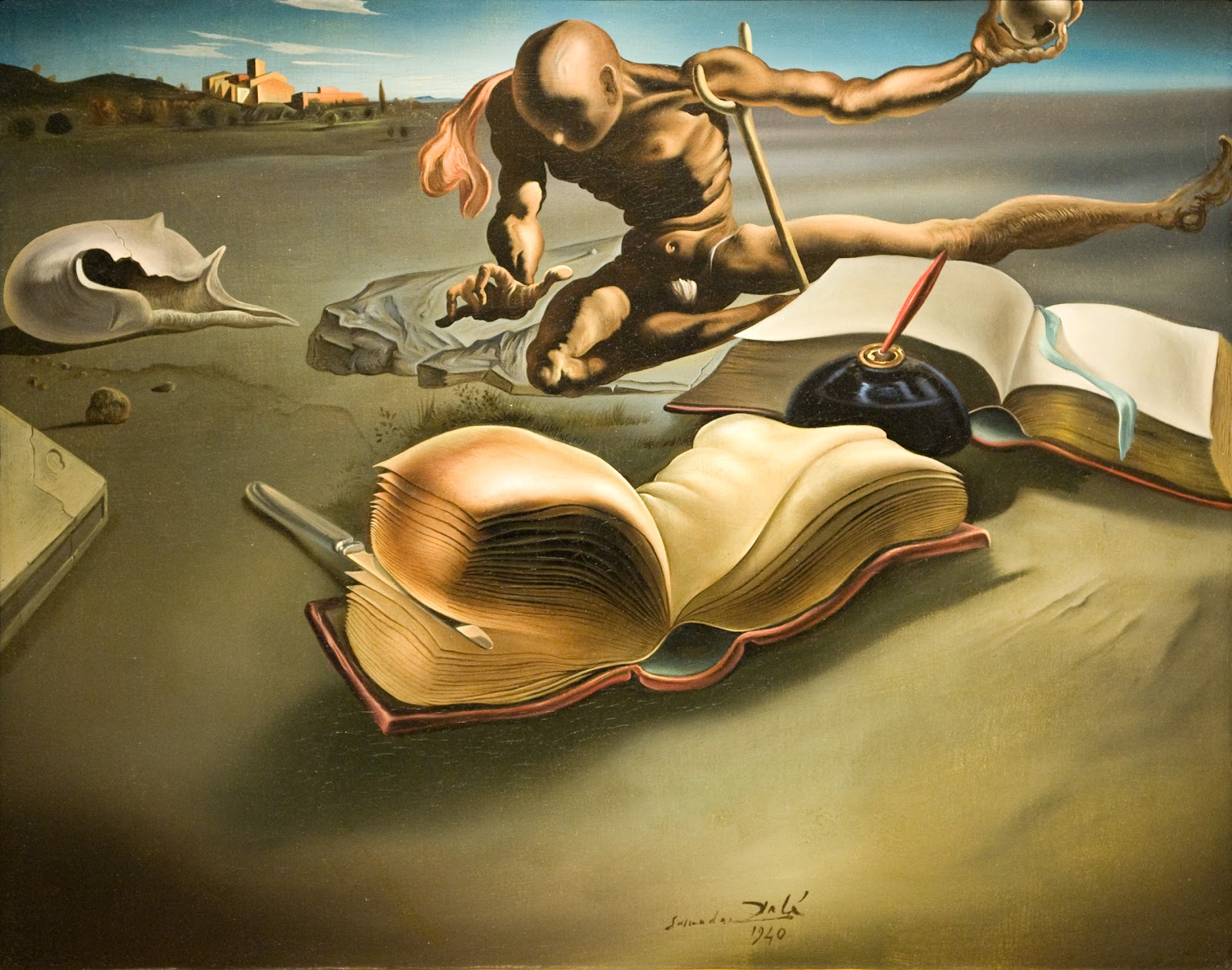
E. L. Doctorow | Quotes / Aforismi
- Scrivere è un'esplorazione. Parti dal nulla, ed impari mentre procedi.
- Writing is an exploration. You start from nothing and learn as you go.
- Pianificare di scrivere non è scrivere. Abbozzare, ricercare, parlare con le persone di quello che stai facendo, nessuna di queste cose è scrivere. Scrivere è scrivere.
- Planning to write is not writing. Outlining, researching, talking to people about what you're doing, none of that is writing. Writing is writing.
Salvador Dali🎨 - Book Transforming Itself into a Woman, 1940
Iscriviti a:
Post (Atom)









